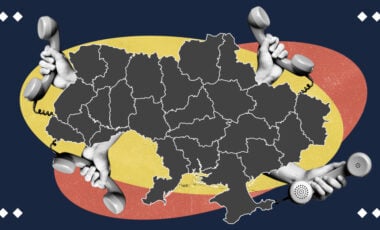Emissions trading: what it is and why Ukraine should study perspectives

The war in Ukraine will accelerate the implementation of a more sustainable environmental policy in Europe, the leading European media assure. A radical paradigm shift in the context of our country's interests and interesting facts that have remained out of the public eye.
A war criminal has done what generations of green activists have failed to do
At the end of 2022, the editorial board of the leading European publication Politico published its annual ranking of prominent people in terms of promoting the development of the European Green Deal. The president of a terrorist country is listed at number one. This is no mistake; the war criminal has accelerated the green revolution in Europe.
The explanation is simple. The EU imports 90% of the gas it consumes, and before the invasion, Russia provided 46% of its total consumption, 27% of its oil imports, and 46% of its coal imports (Source: European Commission 2022)., dwarf has resorted to blackmail by manipulating energy supplies to force Europe to withdraw its support for Ukraine. Despite the risks, the EU's political response was a pleasant surprise:
- cutting off oil, gas and coal supplies from Russia;
- obtaining fossil fuels from other places;
- deployment of renewable energy technologies and energy saving measures.
Therefore, the new paradigm of the EU's energy and climate policy emerged in a secret bunker somewhere in Russia. Another miscalculation by the dictator put an end to the debate over environmental protection that had been going on for years.
The attack on Ukraine forced our government and businesses to temporarily abandon many social initiatives, removing environmental safety from their priorities. At the same time, EU member states have increased their attention to the climate agenda. Despite the determination demonstrated by European countries to achieve their own climate goals, the question of the impact of the events in Ukraine on the region's ecology remains open. Is environmental stability in Europe possible without "intensive therapy" aimed at improving the situation in Ukraine?
An elephant in the china shop
The media and the so-called global "green" lobby have repeatedly tried to draw attention to the fact that the amount of emissions from the military industry cannot be ignored even in peacetime, let alone during military operations. According to the CEOBS (Conflict and Environment Observatory), the military is responsible for 5.5% of all greenhouse gas emissions in the world. Usually, environmental assessment is not considered a priority during armed conflicts. However, it was the aggressive environmental diplomacy of the Ukrainian delegation at the UN COP27 summit that helped bring the discussion of the climate impacts of armed conflict to the international level. This is a very important step, given that the objective picture of the environmental situation in the country is of particular concern.
Experts estimate that emissions during the first seven months of the invasion amounted to 100 million tons of CO2. This is equivalent to the total emissions of the Netherlands. Ukraine was the first country to equate the emissions from the invasion with those of entire countries, emphasizing the importance of such an assessment for understanding the state of the environment as a whole.
One hundred million tons of excess carbon heating the atmosphere is not the only environmental problem. Overall, environmental degradation during the war is occurring through thousands of incidents over hundreds of square kilometers, every day. Most of these incidents have signs of intentional damage to the environment, which is considered a war crime under international law.
The war and its aftermath are already threatening the future, affecting air, water, land, plants, animals and people.
Emissions trading: what it is and why Ukraine should look into it
According to the BBC, more than 2,500 "environmental crimes" have been documented since the beginning of the war, including deforestation, toxic gas emissions, and damage to water facilities. According to the Minister of Environmental Protection of Ukraine, the damage caused by the Russian invasion is already measured in tens of billions of dollars. However, the financial value of the damage does not reflect the true impact on ecosystems or human health.
The unprecedented nature and need for attention to the topic of war and the environment is also confirmed by the number of times Ukraine appears in the reports of the international research group CEOBS (Conflict and Environment Observatory), which studies the impact of armed conflicts on the environment. There are 8 digests devoted to the war in Ukraine, 6 of which were published in the last 11 months. This is an important indicator, because in general, Ukraine appears relatively regularly in the context of war and the environment, but the vast majority of publications simply state the fact of the impact without delving into the issue.
An apt Pupil, we need to remind that our partners
Ukraine has always sought to be seen as an apt partnerwhen it comes to green issues. For example, Directive 2010/75/EU, the ways to implement which, even under different governments, have been worked out very actively.
The Directive explains ways to eco-modernize production and is considered one of the most difficult reforms that Ukraine has to implement as part of its integration into the EU. However, according to Evropeiska Pravda (which cites the APENA2 project), the environment is not among the top topics of European interest. Interestingly, in the context of the war and the environment, the US wrote about Ukraine the most, which seems strange given the territorial proximity and EU involvement in external and internal sociopolitical events.
Industrial emissions have decreased – a sad fact
Since the attack on our country, emissions have fallen by almost half. At any other time, this would be good news, but the reduction was due to the criminal actions of the occupying forces, not to the introduction of green technologies and new projects. The KSE Institute (a think tank at the Kyiv School of Economics) released the following data at the end of the year.
Industry – almost 500 damaged or destroyed enterprises and factories. Energy sector – almost 50% of the infrastructure was destroyed. Heat supply – more than 400 critical infrastructure facilities, including three completely destroyed TPPs, seven damaged and four destroyed CHPs, and almost four hundred boiler houses. Sievierodonetsk TPP was destroyed, Kryvyi Rih, Kurakhiv, and Zmiiv TPPs were damaged, Slovyansk TPP was shut down, and Kherson TPP and Starobeshevo TPP are under occupation. Some of the surviving plants have temporarily suspended operations, while the rest, due to war-related restrictions, operate at no more than 30-50% of their capacity.
This is the only reason why industrial emissions have declined. Industry and energy are no longer the main emitters of excess carbon into Ukraine's atmosphere. However, the environmental damage and emissions caused by the aggressor's actions are several times higher than in even the most depressed years.
Emissions are an odd and promising commodity for Ukraine
The emissions trading system (ETS) is located in Europe and has a single mission: to reduce emissions to achieve climate goals. The EU ETS accounts for the majority of carbon market transactions worldwide. According to Refinitiv, (London Stock Exchange Group), the world's largest provider of financial market data and infrastructure, despite the fact that the number of transactions decreased by more than 20% compared to last year, global transactions amounted to 865 billion euros, which is 14 percent more than in 2021.
Why is this important for Ukraine? Because most companies that buy loans on a voluntary basis could invest them in projects located in Ukraine. During the year of resistance to the occupier, Ukraine has become the main region in need of social and environmental assistance. Carbon certificate holders could invest in projects aimed at restoring and promoting the development of post-war Ukraine. This is exactly why projects to compensate for excess carbon in the atmosphere were created.
Due to the war and a number of other factors, the cost of one ton of emissions averages 80 euros, which is 50% more than in the previous year, and for the sixth year in a row, analysts have recorded a new record for the cost of a ton of carbon.
This is a huge market whose main goal is to ensure that climate goals are met across the planet. Europe continues to burn coal because, under current market conditions, the carbon price does not have an immediate impact on emissions reductions. For gas to be more profitable than coal, a price of about 200 euros per ton is needed. But the situation can change at any time.
Due to the enemy's actions, our country is in the most vulnerable position, turning into a huge inflamed infected environmental wound that threatens the whole of Europe. Air, water bodies, loss of biodiversity, the number of mines, mental and physiological diseases caused by the war. A healthy country is under threat. Without quick and effective intervention, "treatment" is impossible. We never tire of repeating: government and independent business experts should pay more attention to this dynamic and incredibly fast-growing market. Our team is currently working on projects to create and attract carbon offset credits aimed at rebuilding Ukraine.
How all the above factors are connected
Against the backdrop of the actions of the invaders that brought death to a modern, prosperous, independent country, environmental issues are not perceived as the ones that should be addressed as a matter of priority. But this is a misconception.
War has cascading effects on the global economy. Climate change, seriously disrupting food, energy and financial markets. Over the year, we have faced huge environmental challenges and unprecedented greenhouse gas emissions. Compared to 2021, the total area of forest fires has increased 100 times. We must remember, and try not to let the democratic community forget, that the consequences of the war of aggression will be felt in Ukraine and beyond for decades to come, even after the victory.
The financial needs for reconstruction and recovery in Ukraine amount to 349 billion euros, and the figure continues to grow every day (according to the European Commission, the World Bank, and the Government of Ukraine). In addition, the cost of implementing renewable energy sources is decreasing, while such projects have a significant investment appeal and Western partners understand this. In addition, many people around the world want to witness the last gasp of Russia as an energy power and a state in general.
Where to get money for the environment
The topic of the Russian-Ukrainian war is considered mainly in the context of financial problems of people and the state, while less attention is paid to the impact on the environment. But environmental damage can be translated into a financial equivalent.
Almost all large industrial and energy facilities have been destroyed, so it would be quite possible to focus not only on rebuilding, but also on rebuilding with modern environmental requirements in mind when restoring them. That is, we would still have to do this to join the EU, but a properly formed and presented concept of such eco-reconstruction projects would make it much easier to attract structural funds. To do this, we need to be very active in the environmental expert community today. This will help to prepare a high-quality legislative framework that would allow us to finally launch the reform, guaranteeing security and other incentives for third-party investors or donors.
EU countries began environmental modernization in the 80s and 90s of the last century. It was a long way, but it allowed European industry to reduce energy consumption and reduce the impact of toxic substances on the environment. Their experience can be useful to us and will significantly speed up the implementation of such projects.
By the way, in 2000-2020 alone, EU companies received approximately €610 billion in state aid from EU structural funds for environmental protection and energy efficiency measures. This suggests that the EU is really paying close attention to the region's ecology and has budget reserves specifically for green projects.
There are also high hopes for the UN General Assembly, which could adopt a resolution to seize and re-profile Russian funds stored abroad. By the way, some of these funds could go to the owners of passenger planes that Russia has stolen from other countries.
Emissions trading. This is a relatively new but quite attractive market. Experts should pay more attention to this particular area because the territory of Ukraine is likely to become an object of innovative eco-technologies. In general, the topic deserves a separate article.
Conclusions
Foreigners do not live in the paradigm of war, they have their own everyday affairs, their own problems at the local and national level. Our task is to convey to them the message that without a healthy Ukraine, achieving climate goals in Europe is impossible. The environmental damage caused by Russia in Ukraine is more visible than in other armed conflicts. Radiation risks, global insecurity of fossil energy sources, risk of food exports, global warming. The world has already felt the transcontinental and interconnected impact of this war.
Optimistic appeals and the belief that "everything will be fine" should not mislead Ukrainians, and without decisive action at all levels: from ordinary citizens to diplomatic missions, we must remember that no one needs to rebuild our country and overcome the ruin as much as we do. Therefore, we have a good chance of avoiding potential shortcomings by thinking about the future today.
States and non-state actors should raise the environmental aspects of the war in Ukraine in discussions in all relevant multilateral forums and international agreements, as well as in broader exchanges on peace, security and the protection of the population.
365 days of support for each other – the modern world has never witnessed such solidarity within one country. The intensity of support for Ukrainians by Ukrainians is an impetus that has not abated for over a year. If we manage to maintain this trend after our victory, we can count on a significant reduction in the recovery period despite all the obstacles.
Author: Sergiy Dubinevych, CEO & Founder, FuelWell – a technology for reducing carbon footprint and other hazardous emissions from transportation. Expert in the development and implementation of carbon offset projects.





















































